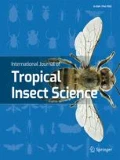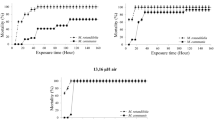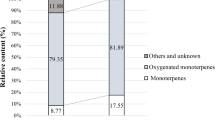Abstract
Essential oils may provide green and safe alternatives to currently used fumigants and insecticides for the management of stored-product insects. This study reports the chemical analysis and fumigant toxicity of 10 essential oils against Tribolium confusum. The essential oils were obtained by hydrodistillation. The chemical profile of essential oils was determined by gas chromatography-mass spectrometry. The essential oils consisted mainly of monoterpene hydrocarbons and oxygenated monoterpenes except the oil of Artemisia monosperema which was enriched with benzenes. The essential oil of Schinus molle (LC50 = 2.22 μl/L air) revealed the highest toxicity against T. confusum eggs, followed by Calistemon viminalis (LC50 = 5.38 μl/L air) and Eucalyptus camaldulensis (LC50 = 5.80 μl/L air) after 7 days of exposure. The toxicity of essential oils against larvae improved significantly with increasing exposure time. The oils Origanum vulgare and Cupressus macrocarpa caused the highest larval mortality with LC50 values of 22.81 and 25.11 μl/L, respectively, after 7 days of exposure. Furthermore, O. vulgare essential oil was the most potent toxicant against adults after three exposure times displaying LC50 values of 5.59, 1.57 and 1.26 μl/L air after 1, 3 and 7 days, respectively. Furthermore, the essential oils of Citrus paradisi, A. monosperema, E. camaldulensis and S. molle displayed promising fumigant toxicity against adults. Based on the obtained results, the essential oils of O. vulgare, S. molle, C. viminals, C. paradisi and A. monosperema had potent fumigant toxicity against T. confusum different stages and they could be applicable for the management of this insect.
Similar content being viewed by others
References
Abdelgaleil SAM (2010) Molluscicidal and insecticidal potential of monoterpenes on the white garden snail, Theba pisana (Muller) and the cotton leafworm, Spodoptera littoralis (Boisduval). Appl Entomol Zool 45:425–433
Abdelgaleil SAM, Mohamed MIE, Badawy MEI, El-arami SAA (2009) Fumigant and contact toxicities of monoterpenes to Sitophilus oryzae (L.) and Tribolium castaneum (Herbst) and their inhibitory effects on acetylcholinesterase activity. J Chem Ecol 35:225–232
Abd-Elhady HK (2012) Insecticidal activity and chemical composition of essential oil from Artemisia judaica L. against Callosobruchus maculatus (F.) (Coleoptera: Bruchidae) J Plant Prot Res 52:347–352
Abdel-Sattar E, Zaitoun AA, Farag MA, Gayed SH, Harraz FMH (2010) Chemical composition, insecticidal and insect repellent activity of Schinus molle L. leaf and fruit essential oils against Trogoderma granarium and Tribolium castaneum. Nat Prod Res 24:226–235
Adams RP (2004) Identification of essential oil components by gas chromatography/mass spectroscopy. Allured Publishing Corporation, Carol Stream (IL)
Ajayi OE, Oladipupo SO, Ojo TB (2018) The fumigant toxicity of Syzygium aromaticum and Cymbopogon citratus oils on selected life stages of Tribolium castaneum (Coleoptera: Tenebrionidae). Jordan J Bio Sci 11:571–575
Amri I, Hanana M, Jamoussi B, Hamrouni L (2015) Chemical composition of Thuja orientalis L. essential oils and study of their allelopathic potential on germination and seedling growth of weeds. Arch Phytopathol Plant Protect 48:18–27
Antonious AG, El-Orabi MN, Salama SI, Sawires SG (2007) Gamma irradiation effects on some biological aspects of Ephestia Kuehniella (Zell.), inherited sterility and mating competitiveness. Arab J Nucl Sci Appl 40:242–250
Bakkali F, Averbeck S, Averbeck D, Idaomar M (2008) Biological effects of essential oils—a review. Food Chem Toxicol 46:446–475
Bendaoud H, Romdhane M, Souchard JP, Cazaux S, Bouajila J (2010) Chemical composition and anticancer and antioxidant activities of Schinus molle L. and Schinus terebinthifolius Raddi berries essential oils. J Food Sci 75:466–472
Boukhatem MN, Kameli A, Saidi F (2013) Essential oil of Algerian rose-scented geranium (Pelargonium graveolens): Chemical composition and antimicrobial activity against food spoilage pathogens. Food Cont 34:208–213
Bouzeraa H, Bessila-Bouzeraa M, Labed N (2019) Repellent and fumigant toxic potential of three essential oils against Ephestia kuehniella. Biosyst Divers 27:349–353
Brari J, Thakur D (2018) Larvicidal effects of eight essential oils against Plodia interpunctella and Tribolium castaneum, serious pests of stored products worldwide. J Entomol Zool Stud 6:738–742
Campolo O, Giunti G, Russo A, Palmeri V, Zappala L (2018) Essential oils in stored product insect pest control. J Food Qual. https://doi.org/10.1155/2018/6906105
Carpenter LJ, Reimann S, Burkholder JB, Clerbaux C, Hall BD, Hossaini R, Laube JC, Yvon-Lewis SA (2014) Ozone-depleting substances (ODSs) and other gases of interest to the Montreal protocol. Scientific Assessment of Ozone Depletion: 2014, Global Ozone Research and Monitoring Project—Report No. 55, World Meteorological Organization, Geneva
Carroll JF, Tabanca N, Kramer M, Elejalde NM, Wedge DE, Bernier UR, Coy M, Becnel BD, Başer KHC, Zhang J, Zhang S (2011) Essential oils of Cupressus funebris, Juniperus communis, and J. chinensis (Cupressaceae) as repellents against ticks (Acari: Ixodidae) and mosquitoes (Diptera: Culicidae) and as toxicants against mosquitoes. J Vector Ecol 36:258–268
Chaubey MK (2008) Fumigant toxicity of essential oils from some common spices against pulse beetle, Callosobruchus chinensis (Coleoptera: Bruchidae). J Oleo Sci 57:171–179
Enan EE (2001) Insecticidal activity of essential oils: octopaminergic sites of action. Comp Biochem Physiol 130:325–337
Finney DJ (1971) Probit Analysis, 3rd edn. Cambridge University Press, London, p 318
Guo Z, Ma Z, Feng J, Zhang X (2009) Inhibition of Na+, K+-ATPase in housefly (Musca domestica L.) by terpinen-4-ol and its ester derivatives. Agric Sci China 8:1492–1497
Gurusubramanian G, Krishna SS (1996) The effects of exposing eggs of four cotton insects pests to volatiles of Allium sativum (Liliaceae). Bull Entomol Res 86:29–31
Harkat-madouri L, Asma B, Madani K, Si ZB, Rigou P, Grenier D, Allalou H, Remini H, Adjaoud A, Boulekbache-makhlouf L (2015) Chemical composition, antibacterial and antioxidant activities of essential oil of Eucalyptus globulus from Algeria. Ind Crop Prod 78:148–153
Herrera JM, Zunino MP, Dambolena JS, Pizzolitto RP, Gañan NA, Lucini EI, Zygadlo JA (2015) Terpene ketones as natural insecticides against Sitophilus zeamais Ind Crops. Prod 70:435–442
Isikber AA, Alma MH, Kanat M, Karci A (2006) Fumigant toxicity of essential oils from Laurus nobilis and Rosmarinus officinalis against all life stages of Tribolium confusum. Phytoparasitica 34:167–177
Isman MB (2000) Plant essential oils for pest and disease management. Crop Prot 19:603–608
Janackovic P, Novakovic J, Sokovic M, Vujisic L, Giweli AA, Dajic-Stevanovic Z, Marin PD (2015) Composition and antimicrobial activity of essential oils of Artemisia judaica, A. herba-alba and A. arborescens from Libya. Arch Biol Sci 67:455–466
Jankowska M, Rogalska J, Wyszkowska J, Stankiewicz M (2017) Molecular targets for components of essential oils in the insect nervous system—a review. Molecules 23:34
Khan M, Mousa AA, Syamasundar KV, Alkhathlan HZ (2012) Determination of chemical constituents of leaf and stem essential oils of Artemisia monosperma from central Saudi Arabia. Nat Prod Commun 7:1079–1082
Kim S, Kang J, Park I (2013) Fumigant toxicity of Apiaceae essential oils and their constituents against Sitophilus oryzae and their acetylcholinesterase inhibitory activity. J Asia-Pac Entomol 16:443–448
Koutsaviti A, Antonopoulou V, Vlassi A, Antonatos S, Michaelakis A, Papachristos DP, Tzakou O (2018) Chemical composition and fumigant activity of essential oils from six plant families against Sitophilus oryzae (Col: Curculionidae). J Pest Sci 91:873–886
Liao M, Xiao J-J, Zhou L-J, Liu Y, Wu X-W, Hua R-M, Wang G-R, Cao H-Q (2016) Insecticidal activity of Melaleuca alternifolia essential oil and RNA-Seq analysis of Sitophilus zeamais transcriptome in response to oil fumigation,” PLoS One 11 (12) Article ID e0167748
Lopez M, Jordan M, Pascual-Villalobos M (2008) Toxic compounds in essential oils of coriander, caraway and basil active against stored rice pest. J Stored Prod Res 44:273–278
Mahmoudvand M, Abbasipour H, Basij M, Hosseinpour MH, Rastegar F, Nasiri MB (2011) Fumigant toxicity of some essential oils on adults of some stored-product pests. Chil J Agric Res 71:83–89
Malizia RA, Cardell DA, Molli JS, González S, Guerra PE, Grau RJ (2000) Volatile constituents of leaf oils from the Cupressaceae Family: Part I. Cupressus macrocarpa Hartw., C. arizonica Greene and C. torulosa Don species growing in Argentina. J Essent Oil Res 12:59–63
Mediouni Ben Jemaa J, Tersim N, Toudert KT, Khouja ML (2012) Insecticidal activities of essential oils from leaves of Laurus nobilis L. from Tunisia, Algeria and Morocco, and comparative chemical composition. J Stored Prod Res 48:97–104
Michaelides PK, Wright DJ (1997) Activity of soil insecticides on eggs of Diabrotica undecimpunctata howardi: effects on embryological development and influence of egg age. Pestic Sci 49:1–8
Mohamed MIE, Abdelgaleil SAM (2008) Chemical composition and insecticidal potential of the essential oils from Egyptian plants against Sitophilus oryzae (L.) (Coleoptera: Curculionidae) and Tribolium castaneum (Herbst) (Coleoptera: Tenebrionidae). Appl Entomol Zool 43:599–607
Mondal M, Khalequzzaman M (2006) Toxicity of essential oils against red flour beetle, Tribolium castaneum (Herbst) (Coleoptera: Tenebrionidae). J Bio-Sci 14:43–48
Moravvej G, Abbar S (2008) Fumigant toxicity of citrus oils against cowpea seed beetle Callosobruchus maculatus (F.) (Coleoptera: Bruchidae). Pak J Biol Sci 11:48–54
Mubarak EE, Mohajer S, Ahmed I, Mat Taha R (2014) Essential oil compositions from leaves of Eucalyptus camaldulensis and Callistemon viminalis originated from Malaysia. Int Proc Chem Biol Environ Eng 70:137–141
Nattudurai G, Baskar K, Paulraj MG, Islam VIH, Ignacimuthu S, Duraipandiyan V (2017) Toxic effect of Atalantia monophylla essential oil on Callosobruchus maculatus and Sitophilus oryzae. Environ Sci Pollut Res 24:1619–1629
Nayak MK, Daglish GJ, Phillips TW, Ebert PR (2020) Resistance to the fumigant phosphine and its management in insect pests of stored products: a global perspective. Annu Rev Entomol 65:333–350
Ndomo AF, Tapondjoul A, Ngamo LT, Hance T (2010) Insecticidal activities of essential oil of Callistemon viminalis applied as fumigant and powder against two bruchids. J Appl Entomol 134:333–341
Negahban M, Moharramipour S, Sefidkon F (2006) Chemical composition and insecticidal activity of Artemisia scoparia essential oil against three coleopteran stored-product insects. J Asia-Pac Entomol 9:381–388
Nenaah GE (2014) Chemical composition, insecticidal and repellence activities of essential oils of three Achillea species against the Khapra beetle (Coleoptera: Dermestidae). J Pest Sci 87:273–283
Nishimura H (2001) Aroma constituents in plants and their repellent activities against mosquitoes. Aroma Res 2:257–267
Nowrouziasl F, Shakarami J, Jafari S (2014) Fumigation toxicity of essential oils from five species of Eucalyptus against adult of Sitophilus oryzae L. (Coleoptera: Curculionidae). Int J Agric Innov Res 2:641–644
Ogendo JO, Kostyukovsky M, Ravid U, Matasyoh JC, Deng AL, Omolo EO, Kariuki ST, Shaaya E (2008) Bioactivity of Ocimum gratissimum L. oil and two of its constituents against five insect pests attacking stored food products. J Stored Prod Res 44:328–334
Ozcan MM, Chalchat JC (2006) Effect of collection time on chemical composition of the essential oil of Foeniculum vulgare subsp. piperitum growing wild in Turkey. Eur Food Res Technol 224:279–281
Pavela R (2015) Essential oils for the development of eco-friendly mosquito larvicides: a review. Ind Crops Prod 76:174–187
Prajapati V, Tripathi AK, Aggarwal KK, Khanuja SPS (2005) Insecticidal, repellent and oviposition-deterrent activity of selected essential oils against Anopheles stephensi, Aedes aegypti and Culex quinquefasciatus. Bioresour Technol 96:1749–1757
Rajendran S, Sriranjini V (2008) Plant products as fumigants for stored-product insect control. J Stored Prod Res 44:126–135
Rees D (2004) Insects of Stored Products, CSIRO Publishing, Collingwood, Vic., Australia
Rossi Y, Canavoso L, Palacios S (2011) Molecular response of Musca domestica L. to Mintostachys verticillata essential oil, (4R)(+)-pulegone and menthone. Fitoterapia 83:336–342
Sahaf BZ, Moharramipour S, Meshkatalsadat MH (2007) Chemical constituents and fumigant toxicity of essential oil from Carum copticum against two stored product beetles. Insect Sci 14:213–218
Sahaf BZ, Moharramipour S, Meshkatalsadat MH (2008) Fumigant toxicity of essential oil from Vitex pseudo-negundo against Tribolium castaneum (Herbst) and Sitophilus oryzae (L). J Asia-Pac Entomol 11:175–179
Sahin F, Güllüce M, Daferera D, Sökmen A, Sökmen M, Polissiou M, Agar G, Özer H (2004) Biological activities of the essential oils and methanol extract of Origanum vulgare spp. vulgare in the Eastern Anatolia region of Turkey. Food Cont 15:549–557
Saroukolai AT, Moharramipour S, Meshkatalsadat MH (2010) Insecticidal properties of Thymus persicus essential oil against Tribolium castaneum and Sitophilus oryzae. J Pest Sci 83:3–8
Sener O, Arslan M, Demirel N, Uremis I (2009) Insecticidal effects of some essential oils against the confused flour beetle (Tribolium confusum du Val) (Col.: Tenebrinoidea) in stored wheat. Asian J Chem 21:3995–4000
Shaaya E, Kostjukovski M, Eilberg J, Sukprakarn C (1997) Plant oils as fumigants and contact insecticides for the control of stored-product insects. J Stored Prod Res 33:7–15
Tarigan S, Dadang I, Sakti Harahap I (2016) Toxicological and physiological effects of essential oils against Tribolium castaneum (Coleoptera:Tenebrionidae) and Callosobruchus maculatus (Coleoptera: Bruchidae). J Biopest 9:135–147
Tomova B, Waterhouse J, Doberski J (2005) The effect of fractionated Tagetes oil volatiles on aphid reproduction. Entomol Exp Appl 115:153–159
Tripathi A, Upadhyay S, Bhuiyan M, Bhattacharya P (2009) A review on prospects of essential oils as biopesticide in insect-pest management. J Pharmacogn Phytother 1:52–63
Tsiri D, Kretsi O, Chinou IB, Spyropoulos CG (2003) Composition of fruit volatiles and annual changes in the volatiles of leaves of Eucalyptus camaldulensis Dehn growing in Greece. Flav Fragr J 18:244–247
Tunc I, Berger BM, Erler E, Dagli E (2000) Ovicidal activity of essential oils from five plants against two stored-product insects. J Stored Prod Res 36:161–168
Viuda-Martos M, Ruiz-Navajas Y, Fernández-López J, Pérez-Álvarez JA (2009) Chemical composition of mandarin (C. reticulata L.), grapefruit (C. paradisi L.), lemon (C. limon L.) and orange (C. sinensis L.) essential oils. J Essent Oil Bearing Plants 12:236–243
Yang Y, Isman MB, Tak J-H (2020) Insecticidal activity of 28 essential oils and a commercial product containing Cinnamomum cassia bark essential oil against Sitophilus zeamais Motschulsky. Insects 11:474
Ziaee M, Moharramipour S, Francikowski J (2014) The synergistic effects of Carum copticum essential oil on diatomaceous earth against Sitophilus granarius and Tribolium confusum. J Asia-Pac Entomol 17:817–822
Acknowledgements
This work was partially supported by the Alexandria University Research Fund (ALEX-REP).
Author information
Authors and Affiliations
Corresponding author
Ethics declarations
Conflict of interest
The authors declare that they have no conflict of interest.
Additional information
Publisher's Note
Springer Nature remains neutral with regard to jurisdictional claims in published maps and institutional affiliations.
Rights and permissions
About this article
Cite this article
Gad, H.A., Hamza, A.F. & Abdelgaleil, S.A.M. Chemical composition and fumigant toxicity of essential oils from ten aromatic plants growing in Egypt against different stages of confused flour beetle, Tribolium confusum Jacquelin du Val. Int J Trop Insect Sci 42, 697–706 (2022). https://doi.org/10.1007/s42690-021-00592-7
Received:
Accepted:
Published:
Issue Date:
DOI: https://doi.org/10.1007/s42690-021-00592-7




